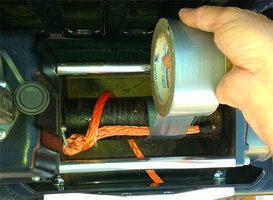After use, the same rules apply since the objective is the same. You need the lower layers tight and compact to prevent the upper layers from sinking down into them under load and getting stuck in the lower layers. The only way to prevent that is to tension the line under load onto the drum.
If we are doing back to back pulls on a long trail recovery and don't have the luxury of tensioning the line, we will move the line by hand so it lays down on the drum with a long x pattern. Or put another way, as it is going in, move it fairly fast across the drum so each layer crosses the one below to create a series of Xs. That is only when we are running out a few drum layers, doing a short pull and then need to reel in the slack to move to the next anchor point. Easier than wadding it all up and shoving it behind the winch or having someone carry it.


